It’s not until after we come back from credits that we finally discover our crime scene. The call Linden took on the shore brings her to a depressing industrial landscape. It’s raining in Washington, like it does sometimes. We get a glimpse of the Seattle skyline in the background, but these ugly crane towers dominate the scene. The subtitle: DAY ONE.
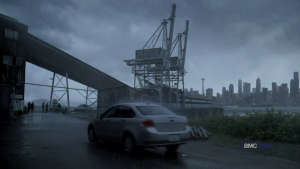
They said it was a bad place to die.
Police tape blocks off the scene. A uniformed officer greets Linden (Detective Linden) at the door to the plant. He runs down the details of the body with the ease of someone who does this every week: “homeless guy found her a couple hours ago. Jane Doe; no ID, wallet …”. Linden takes it all literally in stride, not pausing in her walk as she approaches the building. The officer lets her in, directs her up the stairs, makes some small talk, and then closes the door behind her.
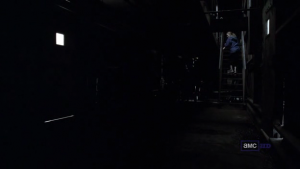
Odd.
Linden pauses on the stairs a second, torn between checking to see why the door was closed and not wanting to waste time with silly questions. Then she presses on. The plant’s all but unlit from the inside. She pulls out a flashlight, but wouldn’t you know, it barely works.
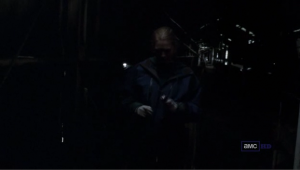
Nothing to be scared of.
Sarah follows a dank passage alongside a metal ramp. Bloodstains spatter the walls. Small animals scurry in the distance. She swings the flashlight around, poking tiny beams of illumination that barely bring any more detail to the shadows around her. She finds bloody clothing at intermittent points. The music builds to an ominous pitch, with those plucked dissonant strings that signify madness.
And then she finds it.
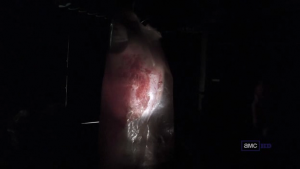
And we know we shouldn’t be scared, because it’s not like a corpse can attack her (at least not in this AMC series), and it’s not like the cops would let her go into the building alone if it weren’t secure, so no one’s going to jump out and stab her or bite her, so the worst that can happen is the corpse looks weird and maggoty, or maybe a rat jumps out of the corner and startles her, or maybe the corpse is someone she recognizes, or it falls off the hook in a big bloody mess just so we jump, all of which are things we’ve seen before, so we’re tense with anticipation but not uncertainty, because there’s only a set number of things that can possibly happen now …
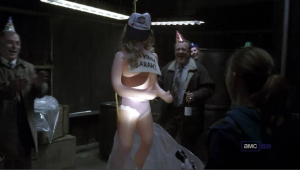
Mrurr?
Oh, wait, it’s a blow-up doll.
What the hell is going on here? We were promised a murder mystery, right? So far we’ve had two total fakeouts. Who the hell does this Veena Sud think she is? Jerking us around like that.
Who says it’s a fakeout?
Well, come on. Finding that dead dog on the beach instead of the girl’s body.
People find dead animals all the time. It doesn’t mean anything.
And following her through this spooky plant, only for the “corpse” to be a blow-up doll.
People throw surprise parties for departing coworkers all the time. So what?
Yeah, but … you know what I mean.
You thought Linden was going to find the body?
Yeah.
Why?
Well … the shot placement. And the way the cuts were edited together. And it’s almost five minutes into the episode now and I’m still not sure we have a body. Much less who got killed.
So?
Hmm.
Eventually, the director stops leading us by the nose and we do in fact get a crime scene. It’s presented in the most off-hand way possible. The lieutenant stops by Linden’s desk, as she’s cleaning it out, and asks if she’ll run down a call. At the scene, Linden and her replacement – the skeezy-looking Detective Holder – find a bloodstained sweater and a discarded bank card.
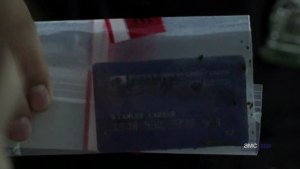
'Stan Larsen,' eh? Another suspicious Dane.
We meet the owner of the bank card, Stan Larsen, in our very next scene. He’s a gruff blue-collar type, arriving at an Arabic butcher shop of some sort to collect a delivery. Seems normal enough. But they always do. It’s that placid exterior that hides the soul of a killer.
Our senses get jacked up to alert when Larsen gets a phone call. “Stan. You need to get home. Right now.”
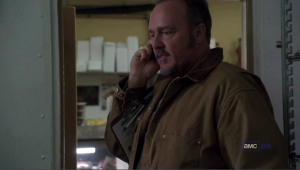
This has to be bad.
So the cops must be at his house right now. They’re grilling his wife. Or else she knows something the cops don’t – like why Stan’s bank card might be in an undeveloped field in the middle of nowhere. Is she worried? Is she mad? Has Stan’s double-life as a murderer/rapist been exposed, forcing him to …
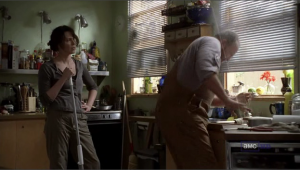
Okay, while this is 'bad', it's not what we had in mind.
… fix a broken sink.
All right, seriously? What the hell? What sort of show am I watching? Right now there’s about as much darkness and deceit on The Killing as on an episode of The Real Housewives of Orange County. The director and the writers have given us three clear lead-ins to a crime scene – the shore, the plant, the suspect called home – and each time they’ve backed off. All we’ve got so far is a woman quitting her job, her douchebag replacement, and some minor domestic trouble. Doesn’t Veena Sud know how a police procedural is supposed to work?
Actually, she does.
The Killing is a police procedural for people who know police procedurals backward and forward. In the pilot, it plays to all the tropes we expect. Nubile victims being chased through the woods by flashlight-wielding killers. Tired cops who’ve seen it all before. Working class suspects. The Killing lays out every scene that we know should be coming. And then it screws with them. Not just once, but three times. Once is happenstance, twice is coincidence, but three times (to quote Ian Fleming) is enemy action.
Why is Sud rattling our expectations like this?
For one, it sends us a message. While the language of a TV script tells a story with the words characters say, the language of film tells a story as well. Shot placement, editing, pacing and soundtrack all communicate a particular message. You wouldn’t shoot our hero cop walking through an unlit warehouse the same way you’d shoot a tired mother coming home to a surprise 40th birthday party. You wouldn’t cut as suddenly from a character receiving a tense phone call from his wife if it were a teacher imparting a lesson to a student in need. The subject matter dictates how the the story is shot.
But Veena Sud (and the director – Patty Jenkins, in the case of the pilot) is framing The Killing like a police procedural, yet at the same time breaking all the rules of police procedurals. If film has a language, then what is the message of this show so far? Abandon your expectations. Put aside your notions of what a police procedural should be like. Take nothing we show you for granted. Your eyes are lying to you.
Sud could have given us this same message in other ways. She could have put it in the mouth of a character: a seasoned old veteran, perhaps, who warns the cocky newcomer that “a real crime scene ain’t like what ya see in the movies, kid.” But she didn’t. There wouldn’t have been anything wrong with that – hundreds of acclaimed series have done it in the past. But only when you see it done onscreen, and with such obvious intent, do you realize how much richer a well-shot teleplay can be.
The second reason Sud does this is more sinister. She’s doing it to create tension. It’s hard to scare someone with a police procedural, partly because the format is so well known. But playing with the tropes of the genre shakes up our expectations. It puts us off balance. We’re not really scared. But our senses are more alert. We can no longer tune out between one scene and the next, because the scenes aren’t ending the way they should. We have to keep paying attention, or else we’ll miss something.
Finally, Sud toys with the audience this way – dangling the death in front of us, like a string in front of a cat – because she wants us to reconsider the death. In a police procedural, death is the MacGuffin: the object that makes the plot go. Our protagonists can’t restore the dead person to life with their efforts. Once you’ve watched enough episodes of Law & Order, the deaths all become interchangeable. Last week it was the ambitious architect; this week it’s the jealous hairstylist; next week it’s the racist landlord. They are not people, but objects: lumps of tissue to be examined by coroners and grieved over by next of kin.
But if that’s not what death is supposed to be, then what is it?
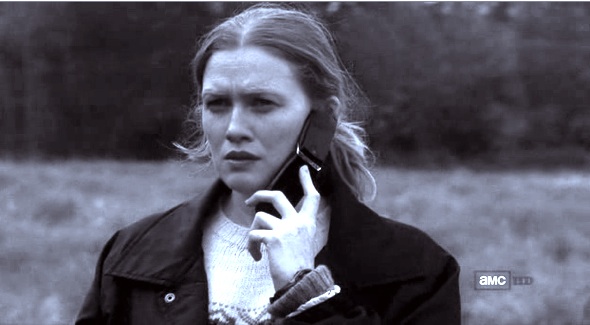
Regarding the Steadicam bit: I’d be willing to put a dollar on the guy being on a Segway, like this Eurovision bit: http://www.youtube.com/watch?v=3f3mUs7rS1I
Day-amn! That’s some fancy footwork!
The Steadicam has always fascinated me. A Steadicam + Segway just blows my mind.
Not just that, though; pity the poor focus guy who had to keep up on foot!
The fakeout crime scene/going away party scene felt off to me as regards the rest of the script’s intelligent twisting of tropes. It came off as too much of ‘he was just one week away from retirement’ for me. That said, I agree that this is a very strong pilot and series thus far (4 episodes in). I give the pilot 9 out of 10 as a result.
I have a very high regard for the pilot episode of Veronica Mars. It succeeds in establishing the many principal characters (and there is no character drift throughout season one) and the overall story arc that ran the entire season. Veronica was a high school girl the likes of which hadn’t been shown on TV (at least not American TV). She was worldly and still young girl-ish.
Regarding character drift I mentioned above, pilot episodes are fascinating to compare to regular season episodes. While a flawed pilot can still produce a good series, a well executed pilot is almost certain to do so. Go back and watch the pilot of The West Wing and I think you’ll agree the only character nailed by the actor was Toby Zeigler (Richard Schiff). Everyone else to varying degrees didn’t understand their character yet (which could well be that Sorkin didn’t yet know them).
The Killing is very good TV, and has already become a show to which I look forward. As to the look, it reminds me of how well Wallander is shot. Both are atypical for series television.
Patrick
I didn’t have time to add Wallander to my list of shows to watch when it first came out, but The Killing has definitely made me want to check it out again. However, the time dilemma is still pretty much the same. :-P
I don’t know if you watched the TV series “Murder One”, but the first season is pretty good – one season, one case, from the litigation perspective. It really did get to delve further into everyone’s lives.
Plus – it’s got Stanley Tucci in it, playing a pretty good sleazeball.
Also, Patricia Clarkson chopped A LOT of vegetables!
Patrick
Great critique – makes a lot of sense! But are you perhaps giving Sud a little too much credit? I haven’t seen the American version, but I have seen the Danish original and it sounds from your description like it’s pretty much a carbon copy of that. Maybe Sud should be praised for not changing it, but I don’t think they are her original ideas …
@Perich: Good critique/review! I’m going to present your observations as my own.
@Zoe: The Killing/Sud is just following a trend in the business. There are a lot of examples of non-english scripts being run thru google translate and then being slapped with the name of a new writer. Examples that immediatly come to mind are Let me in and The next three days.
It’s propably not done in malevolance. It’s maybe a manifestation of somekind of cultural protectionism.
Anyways, the credit hoarding for translating and script doctoring is not helping in building the appreciation that the craft of writing deserves. Methinks…
Great break down, I love the series too. Minor quibble (and the sort of meaningless minutia that is only worth mentioning on a site called Overthinkingit) but Sonoma is in Northern, not Southern California. That stuff matters a great deal to us San Francisccans